Unraveling the Smooth Power: The Role of Sheaves in Gearless Motors
In the intricate dance of modern machinery, every component plays a part in creating harmony, efficiency, and longevity. Among these, the sheave — a seemingly simple wheel or pulley — quietly but powerfully contributes to the elegance of mechanical systems, especially within gearless motors. If you've ever marveled at how smoothly a crane lifts heavy loads or how quiet and efficient a conveyor system runs, there's a chance that a sheave is quietly working behind the scenes.

The Sheave: A Quiet Powerhouse
At its core, a sheave is a wheel with a groove designed to hold a belt, rope, or cable. In its classic applications, sheaves transmit power and motion, shifting forces seamlessly across systems. When integrated into gearless motors, sheaves become critical components that facilitate efficient, reliable operation without the need for gears or complex gearboxes.
Imagine a scenario where a lifting system relies on a gearless motor—this design eliminates the need for traditional gearboxes, reducing mechanical complexity and points of failure. Here, the sheave acts as the pivotal interface that connects the motor's rotation to the load, implementing a smooth transfer of force. Think of it as the conductor of an orchestra, ensuring all instruments (or in this case, forces and motions) are perfectly coordinated.
Why Gearless? A Shift Towards Simplicity and Efficiency
The trend toward gearless motors is driven by a desire for simplicity, less maintenance, and greater efficiency. Adding gears can introduce backlash, increase wear, and diminish overall system lifespan. By removing gears from the equation, engineers aim to create smoother, quieter, and more energy-efficient machinery.
But with this shift, the role of components like sheaves becomes even more critical. The sheave’s design and quality directly influence the overall performance of the gearless motor. Its ability to withstand stress, reduce slippage, and operate quietly impacts the system's reliability.
Designing the Perfect Sheave: Material and Structure
One might think that a simple wheel is just a wheel, but in reality, sheaves in motor applications are meticulously engineered. The choice of material—be it steel, aluminum, or composite—depends largely on the load requirements, environmental conditions, and operating speed.
A well-designed sheave must balance strength with weight. Heavy sheaves can load the motor unnecessarily, leading to energy losses, while overly light sheaves might lack durability. The groove’s profile is equally vital; it must fit the belt or cable perfectly to prevent slippage while minimizing wear.
Advanced manufacturing techniques, such as CNC machining, ensure that sheaves are manufactured to exact tolerances. This precision guarantees smooth operation, reduces vibration, and extends the lifespan of both the sheave and the belt driving it.
Sheaves in Action: Practical Applications
In the field, sheaves in gearless motors are found powering everything from elevators and cranes to conveyor belts and manufacturing equipment. Take the example of an elevator system: a gearless hoisting machine employs a sheave mounted directly to the motor shaft. When the motor energizes, the sheave turns, lifting or lowering the elevator car with remarkable fluidity.
Similarly, in the realm of industrial automation, sheaves help achieve high-speed, low-maintenance operation. Their simplicity means fewer parts to break, and their capacity for smooth, quiet motion makes them ideal where noise reduction is valued.
The Benefits of Using Sheaves in Gearless Motors
Why do so many systems prefer sheaves in gearless setups? The advantages are compelling:
Enhanced Efficiency: Without gearboxes, power transfer is more direct, reducing energy losses. Reduced Maintenance: Fewer moving parts mean less wear and tear, translating to longer service intervals. Smoother Operation: Sheaves provide a flexible interface that accommodates minor misalignments and absorbs shocks. Cost Savings: Simpler designs lower initial investment and ongoing maintenance costs. Compact Design: Eliminating gears allows for more streamlined, space-saving machinery.
Looking Ahead: Innovations in Sheave Technology
The interplay between advances in materials science and manufacturing precision continues to elevate sheave technology. Researchers are exploring composite materials that combine durability with lightweight properties, making sheaves more resilient while reducing energy consumption.
Furthermore, computer-aided design (CAD) and finite element analysis (FEA) facilitate the creation of highly optimized sheaves tailored for specific applications. These innovations promise to push the boundaries of what gearless motors can achieve, emphasizing efficiency, longevity, and performance.
I will provide the second part, which will delve deeper into modern applications, maintenance considerations, and innovative trends in sheave technology—stay tuned!
Established in 2005, Kpower has been dedicated to a professional compact motion unit manufacturer, headquartered in Dongguan, Guangdong Province, China.




































